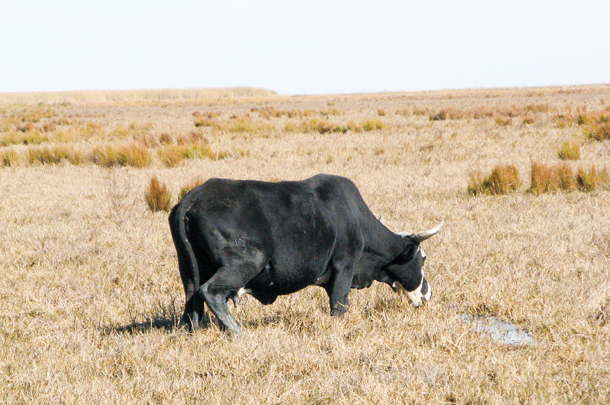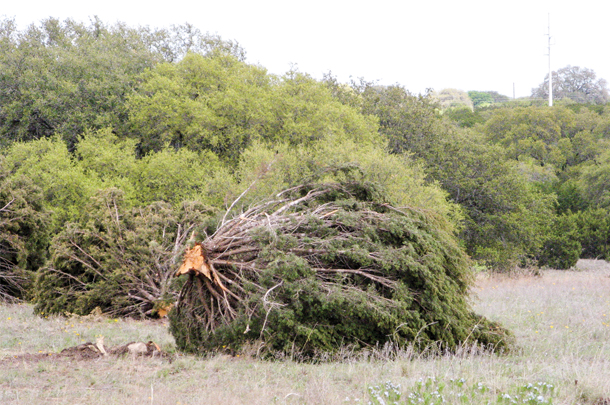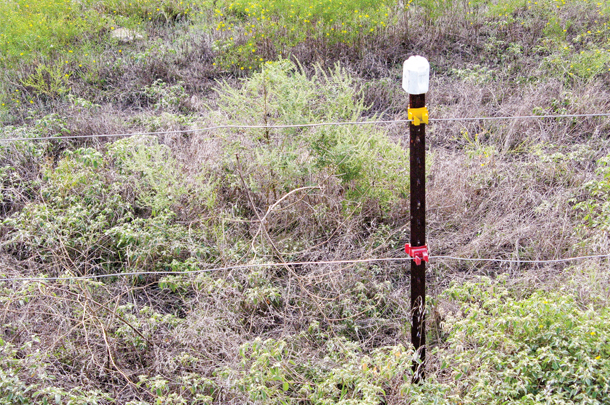Once ticks are redistributed by their hosts to new areas, populations can explode due to one female laying thousands of eggs.
“Ticks frequently use wild animal hosts to maintain tremendous populations in the vicinity of treated cattle herds,” says Donald Johnson, University of Arkansas Cooperative Extension Service. “Ticks produced on wildlife can re-infest treated cattle, and they continually pose a problem for producers.”
Adverse effects on beef cattle
“Heavy infestation of ticks on cattle results in a loss of condition, failure to gain properly and a severe degree of anemia,” Johnson continues. “Tick bites are irritating and cause the infested animal to rub and scratch, resulting in a scabby skin condition and a reduction in hide value."
"Irritated skin condition is sometimes followed by secondary infection. Ticks are also capable of transmitting anaplasmosis to cattle.”

According to the Centers for Disease Control and Prevention (CDC), ticks transmit disease-causing pathogens through their feeding process. When a tick finds an animal on which to feed, it grasps the skin and cuts into the surface.
The tick then inserts its feeding tube. Many species secrete a cement-like substance that keeps them attached to the animal while feeding. Feeding tubes can also have barbs which help keep ticks in place. Ticks can secrete small amounts of saliva with anesthetic properties so that the animal or person can’t feel the attachment.
A tick will suck blood slowly for several days. If the host animal has a blood-borne infection, the tick will ingest the pathogens with the blood. Small amounts of saliva from the tick may also enter the host’s skin during the feeding process.
If the tick contains a pathogen, the organism may be transmitted to the host animal. After feeding, most ticks will drop off the host and prepare for its next life stage. At its next feeding, it can then transmit an acquired disease to the new host.
Life cycles
“There are four stages in the life cycle of ticks – egg, six-legged larva or seed tick, nymph and the adult, which has eight legs,” says Johnson. “The larva, nymph and adult obtain food by piercing the skin of animals and sucking blood. Eggs are laid on the ground, not on the host animal.”
Ticks are referred to as one-, two- or three-host depending on how many animals they must parasitize to complete their life cycle. During the one-host life cycle, ticks remain on the same host for the larva, nymph and adult stages, only leaving the host prior to laying eggs.
In the two-host life cycle, the tick molts from larva to nymph on the first host but will leave the host between the nymph and adult stages. The second host may be the same individual as the first host, the same species or even a second species. Larva, nymph and adult stages of three-host ticks are each spent on a different animal. These three hosts can all be different species of animals.
Types of ticks
There are two well-established families of ticks, the Ixodidae (hard ticks) and Argasidae (soft ticks). Hard ticks have a “plate” on their back that is called a scutum. Soft ticks appear to have a wrinkled body and lack a scutum.
The most important three-host hard ticks found on cattle in the U.S. during the summer are the American dog tick, Rocky Mountain wood tick, Lone Star, winter ticks, Pacific Coast and Gulf Coast tick. A soft tick that bothers cattle is the spinose ear tick and winter ticks.
“Hard ticks seek hosts by an interesting behavior called questing,” explains Larisa Vredevoe of Cal – Poly. “Questing ticks crawl up grass stems or perch on the edges of leaves lying on the ground with front legs extended, especially in response to a passing host. Carbon dioxide, heat and movement serve as stimuli for questing behavior.

Subsequently, these ticks climb onto a potential host that brushes against their extended front legs. Some soft ticks seek hosts by questing on low-lying vegetation, but the vast majority is nest parasites.”
“Although the American dog tick is normally found on dogs, this tick will readily attack larger animals, such as cattle, horses and even humans,” says Phillip Kaufman, University of Florida. “The eight-legged adult is a vector of the pathogens causing Rocky Mountain spotted fever (RMSF) and tularemia (hunter’s disease)."
"The parasite can also be responsible for canine tick paralysis. It is widely distributed in the U.S. east of a line drawn from Montana to south Texas. The tick is found in Canada east of Saskatchewan and in California west of the Cascade and the Sierra Nevada Mountain ranges."
"This species is most abundant in the eastern U.S. from Massachusetts south to Florida but common in the more central areas of the U.S., including Iowa and Minnesota.”
“Rocky Mountain wood tick nymphs primarily feed on small rodents,” says Vredevoe. “As adults they focus on large mammals, especially deer, humans, dogs, wolves, fox and livestock."
"This tick is well known as a vector of the Rocky Mountain spotted fever pathogen, Colorado tick fever virus and the bacteria which causes tularemia. It is often responsible for tick paralysis in humans, livestock and wild mammals.”
The Rocky Mountain wood tick is distributed in western Canada and in the northwestern U.S. It prefers mountainous areas and river bottoms and coulees in dry prairie regions. Presence of shrubby vegetation is a positive indicator of tick habitat.
“Lone Star tick is widely distributed throughout the U.S., commonly found from Texas north to Missouri and eastward to the Atlantic coast,” reports Steven Jacobs, Penn State University.
“Larvae feed on a variety of small animals, and nymphs feed on small as well as large animals. Adults are normally found on large animals, including cattle. All life cycle stages are found on deer. The Lone Star tick is known to vector tularemia, Rocky Mountain spotted fever and causes tick paralysis in man and in dogs.”
“Larva and nymphs of the Pacific Coast tick commonly feed on rodents, especially squirrels,” says Vredevoe. “As adults they feed on cattle, horses, deer and humans. This tick is widely distributed in California and is found in Oregon and Baja Mexico as well.”
“Gulf Coast ticks are found in grass prairies and coastal uplands along the Gulf Coast and north along the Atlantic seaboard to the northern boundary of Virginia,” Kaufman explains. “They are also found in Arkansas and Oklahoma. The ticks feed on a variety of birds and mammals and will readily bite humans.
“Historical importance of Gulf Coast ticks has centered on the impact due to livestock infestations. Gulf Coast tick bites can cause severe inflammation, abscesses and other tissue damage. Livestock infested with Gulf Coast ticks were often recognized by drooping ears, which can reduce market value at sale."
"Gulf Coast ticks are of increasing concern because of their ability to transmit several pathogens of veterinary and medical importance such as Rocky Mountain spotted fever, leptospirosis, heartwater and tick paralysis.”
Spinose ear tick is a one-host soft tick and is found throughout the U.S. “Parasitic larvae and nymphs of this species cause serious damage to livestock,” says Johnson. “They attach in the inner folds of the outer ear and suck blood. Wounds may become infected with pus-forming organisms that give rise to a condition known as canker ear."
"The constant irritation causes animals to become dull, unthrifty and lose weight. Infested animals shake their heads and rub their ears in an attempt to relieve the irritation. The ticks are not vectors of disease. They are spread by introduction of an infested animal or animals into previously uninfested herds.”
“Winter ticks are widely distributed across much of the contiguous U.S. and Alaska,” says Pete Teel, Texas A&M AgriLife Research. “Cattle, horses, mules, deer, elk and moose are primary hosts, but infrequent collections from dogs, feral swine and humans have been recorded."
"The winter tick is a one-host hard tick, completing a life cycle with larvae, nymphs and adults feeding to engorgement on a single host animal.
Larvae typically seek hosts from October to March with activity peaking December to January. Winter parasitism places increased stress on grazing animals already burdened by diminishing forage quality and availability."
"All stages may be found feeding on individual hosts at the same time, and feeding is generally completed in 21 to 28 days. The winter tick vectors the bacterial pathogen that causes anaplasmosis in cattle.”
Tick control
Due to detrimental effects on cattle and potential disease transmittal to people, tick control is an important practice. Various insecticides that offer good tick control are registered as premise and animal treatments. Be sure to thoroughly read and follow the use directions written on the product label.

Pasture rotation aids in control of one-host ticks where duration of the resting period is determined by the relatively short life span of free-living larvae. However, this practice has minimal effects on multi-host ticks or soft ticks because of the long survival periods of unfed nymphs and adults.
“Ticks thrive in high humidity conditions,” says Johnson. “Regular weed and brush control in pastures decreases humidity and greatly reduces tick populations.”
Inspect all purchased cattle for ticks before adding them to the herd. Treat animals infested with ticks and quarantine until they are pest-free. Deer and other wildlife can be notorious for spreading ticks to cattle. Conduct an annual census and cull animals to balance their population with available habitat.
Ticks have short legs, but they can move fast to reduce income from cattle operations. Regularly examine pets for ticks and inspect cattle whenever they are worked. When ticks are found, take the necessary steps to get the pests under control.
Robert Fears is a freelance writer based in Texas.
PHOTO 1: Tick close-up – Photo courtesy of Centers for Disease Control and Prevention.
PHOTO 2: Ticks thrive in high humidity conditions.
PHOTO 3: Brush control is directly related to tick control.
PHOTO 4: Pasture rotation aids in control of one-host ticks. Photos provided by Robert Fears.







